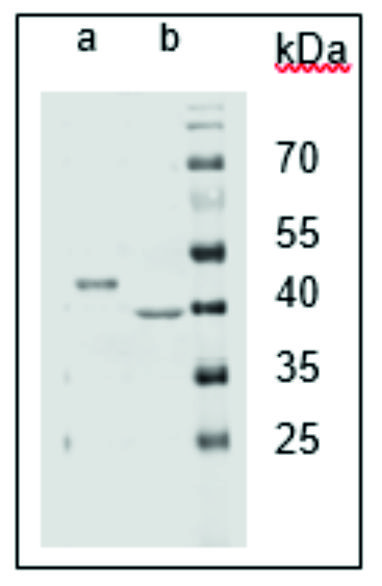murine MAb against human PAI-1, clone HD-PAI-1 23.1
Description
The monoclonal antibody ADG3723 (clone HD-PAI-1 23.1) is a murine monoclonal antibody, subclass IgG2a recognizing the human Plasminogen Activator Inhibitor Type 1 (PAI-1). Mice were immunized with purified recombinant PAI-1, expressed in a prokaryotic expression system. The antibody has been purified from cell culture supernatant using Protein A affinity chromatography. The antibody reacts with both native and recombinant PAI-1
Presentation
Screw capped vial containing 250 µg of purified antibody in PBS pH 7.4 + 0.01% ProClin300. The IgG concentration is given on the vial label. Spin the vial briefly before opening.
Storage and Stability
Store the antibody at 2°-8°C. For long-term storage the antibody should be aliquoted and stored at –20°C or colder. It is recommended to avoid freeze-thaw cycles.
Specificity
The antibody recognizes both active and inactive forms of PAl-1, and in addition it recognizes PAI-1 complexed with urokinase, tissue-type plasminogen activators, or vitronectin.
The antibody is specific for human PAI-1, no cross-reactivity was observed against other members of the plasminogen activator system (PAI-2, uPA, or tPA).
Applications
Western Blot
The antibody is suitable for for immuno-blotting. It recognizes native (a) and recombinant (b) human PAI-1.

Immunohistochemistry
The antibody can be used for immunohistological staining of formalin-fixed, paraffin-embedded tissue sections.
Category: Research use only
Type: Antibody
Product Availability: Worldwide
Manufacturer: ImmBioMed GmbH & Co KG, Germany
For more information please click .pdf icon below.
murine MAb against human PAI-1, clone HD-PAI-1 23.1
Cat.No. ADG3723
Article no.: 938515
Unit: 250 µg
Code: ADG3723
Manufacturer: ImmBioMed GmbH & Co. KG
References
- Epitope Mapping of Monoclonal Antibodies Directed to PAI-1 Using PAI-1/PAI-2 Chimera and PAI-1-Derived Synthetic Peptides. Muehlenweg et al., Throm Res, 98 (2000) 73–81.